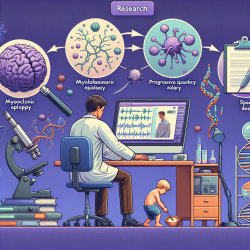Introduction
In the ever-evolving field of special education and therapy services, understanding the intricate interplay between genetics and environmental factors can significantly enhance the support provided to students. A recent study titled Interaction between polygenic risk for cigarette use and environmental exposures in the Detroit neighborhood health study sheds light on this interplay, offering insights that can be leveraged to create more supportive and effective educational environments.
Understanding the Research
The study explores how genetic predispositions to cigarette use interact with environmental factors such as traumatic events and neighborhood social cohesion. By examining a sample of African American residents in Detroit, researchers identified that genetic risk scores (GRS) could predict cigarette use frequency. Moreover, they found that traumatic events increased the expression of genetic predispositions, while strong neighborhood social cohesion diminished it.
Implications for Practitioners
For practitioners in the field of special education and therapy, these findings emphasize the importance of considering both genetic and environmental factors when supporting students. Here are some practical steps practitioners can take:
- Integrate Environmental Assessments: Evaluate the social cohesion and environmental stressors in students' neighborhoods to better understand their behavioral and health challenges.
- Develop Trauma-Informed Practices: Implement strategies that recognize and address the impact of traumatic events on students' behavior and learning.
- Promote Community Engagement: Foster a sense of community and social support within schools to mitigate genetic predispositions to negative behaviors.
Encouraging Further Research
While the study provides valuable insights, it also highlights the need for further research, particularly in diverse populations. Practitioners are encouraged to collaborate with researchers to explore the following areas:
- Longitudinal Studies: Conduct long-term studies to observe how genetic and environmental interactions evolve over time.
- Cross-Population Comparisons: Compare findings across different ethnic and socioeconomic groups to identify universal and unique factors.
- Intervention Efficacy: Test the effectiveness of interventions designed to enhance social cohesion and reduce environmental stressors.
Conclusion
By integrating the findings of this research into practice, educators and therapists can better support students, particularly those at risk due to genetic and environmental factors. The study underscores the potential of targeted interventions to improve health outcomes and foster healthier communities.
To read the original research paper, please follow this link: Interaction between polygenic risk for cigarette use and environmental exposures in the Detroit neighborhood health study.










